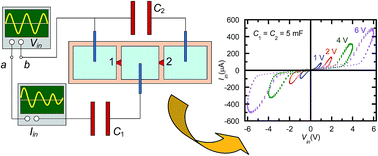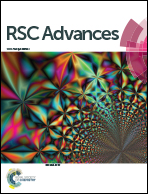Voltage-controlled current loops with nanofluidic diodes electrically coupled to solid state capacitors†
Abstract
We describe experimentally and theoretically voltage-controlled current loops obtained with nanofluidic diodes immersed in aqueous salt solutions. The coupling of these soft matter diodes with conventional electronic elements such as capacitors permits simple equivalent circuits which show electrical properties reminiscent of a resistor with memory. Different conductance levels can be reproducibly achieved under a wide range of experimental conditions (input voltage amplitudes and frequencies, load capacitances, electrolyte concentrations, and single pore and multipore membranes) by electrically coupling two types of passive components: the nanopores (ionics) and the capacitors (electronics). Remarkably, these electrical characteristics do not result from slow ionic redistributions within the nanopores, which should be difficult to control and would give only small conductance changes, but arise from the robust collective response of equivalent circuits. Coupling nanoscale diodes with conventional electronic elements allows interconverting ionic and electronic currents, which should be useful for electrochemical signal processing and energy conversion based on charge transport.


 Please wait while we load your content...
Please wait while we load your content...